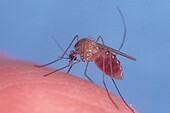
FRIDAY, Oct. 22 (HealthDay News) — Complicating efforts to combat malaria, new research indicates that two physically identical strains of a single mosquito responsible for most disease transmissions appear to be evolving into two genetically distinct species.
Two studies reported in the Oct. 21 issue of Science suggest that the evolution process is occurring faster than previously thought, and note that substantial genetic differences are already apparent. This development could undermine efforts to control mosquito population growth with strategies that may not be effective against both strains, the researchers said.
“Malaria is a deadly disease that affects millions of people across the world, and amongst children in Africa, it causes one in every five deaths,” George Christophides, a professor in the division of cell and molecular biology at Imperial College London in England, said in a news release from the college. Christophides is one of the lead researchers.
“We know that the best way to reduce the number of people who contract malaria is to control the mosquitoes that carry the disease,” he continued. “Our studies help us to understand the makeup of the mosquitoes that transmit malaria, so that we can find new ways of preventing them from infecting people.”
Malaria kills one child every 30 seconds worldwide, according to World Health Organization figures cited in the studies.
The new studies focused on the so-called “M” and “S” strains of the “Anopheles gambiae mosquito,” which is involved in most malarial transmissions in sub-Saharan Africa.
After conducting detailed genetic analyses, the authors of one study concluded that significant genetic differences are dispersed all across each strain’s genome, potentially altering development, eating habits, and reproductive patterns.
The other study examined 400,000 different spots on each strain’s genome and those on a third strain called “Bamako” to hone in on genetic variations.
The research team theorized that the strains seem to be evolving in different directions, perhaps in reaction to environmental differences or divergences in the diseases and predators each mosquito strain must combat.
The research team included scientists from the University of Notre Dame, the J.C. Venter Institute, Washington University and the Broad Institute.
More information
For more on malaria, visit the U.S. National Institutes of Health.

